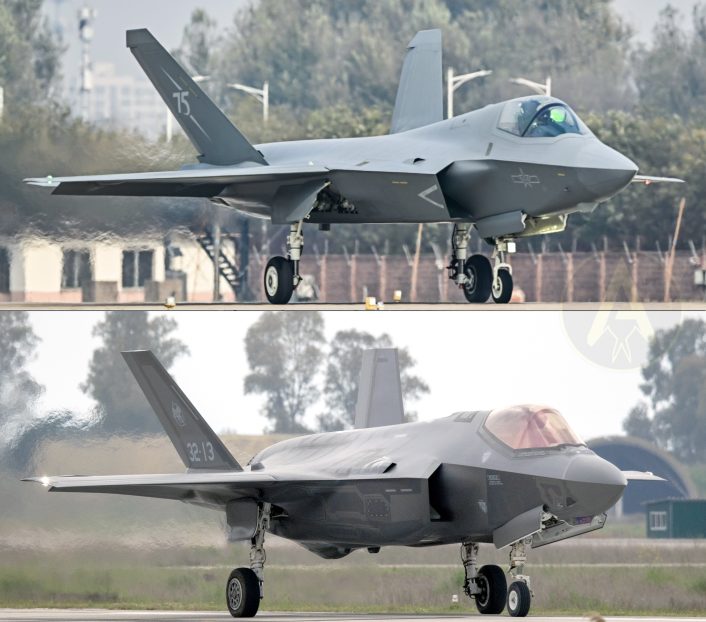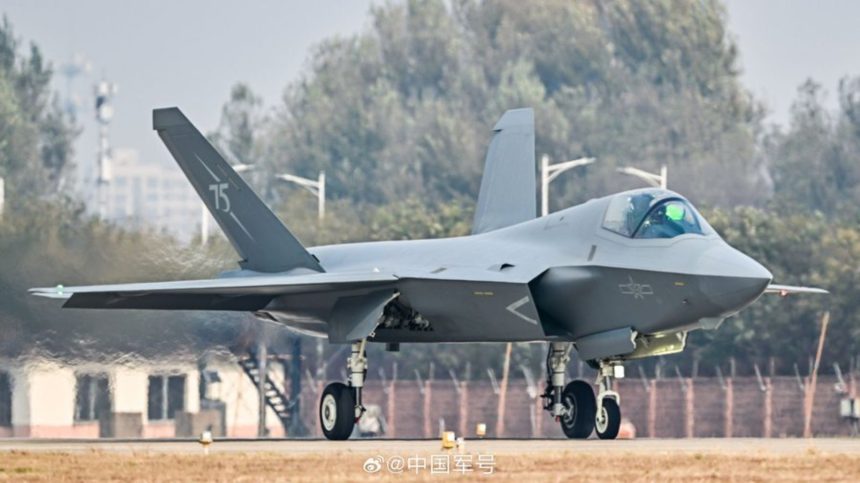With its arrival at Zhuhai airport, the PLAAF has officially unveiled the J-35A, the land-based variant of the J-35. China has been actively marketing for export the aircraft, once known as FC-31 and later J-31, as a cheaper alternative to the F-35.
China’s second stealth fighter, the J-35A, will officially make its debut at the Zhuhai Air Show, which will be held from Nov. 12 to Nov. 17, 2024, the Chinese military has announced. The aircraft, which was initially independently developed by Shenyang as the FC-31 Gyrfalcon and also known as the J-31, is about to be inducted in the PLA Air Force and, notably, sports on its tail a logo for the service’s 75th anniversary.
Two variants are currently being developed, the J-35A seen in Zhuhai for the PLAAF and the J-35 for the PLA Navy. Two obvious differences between the two that immediately catch the eye are the single wheel nose gear of the PLAAF variant, as opposed to the other’s twin wheel nose gear, and the larger and different vertical stabilizers of the PLAAF variant.
The naval J-35, according to the few clear photos circulating online, appears to be also equipped with a launch bar to be able to operate from the CATOBAR (Catapult Assisted Take Off Barrier Arrested Recovery) carrier Fujian. This confirms earlier claims that the jet will be able to operate from all the PLAN aircraft carriers.
Another detail which can be spotted in the photo of the J-35A arrived at Zhuhai airport is the presence of a chin-mounted system equivalent to the F-35’s EOTS (Electro-Optical Tracking System). The system is possibly the same also used by the J-20 “Mighty Dragon”, dubbed EOTS-86.
A possible radar-reflecting Luneburg lens, which was seen below the fuselage in images shared on X by leading Chinese military aviation researcher Andreas Rupprecht in March 2024, can also be identified in the new picture behind the main landing gear. The device is meant for masking the J-35’s real radar signature and to allow it to be detectable by friendly radar sensors and air traffic control.
China’s latest stealth fighter jet J-35A to make its debut at the #AirshowChina2024, which is to be held from Nov. 12-17 in #Zhuhai City, south China’s #Guangdong Province, said a Chinese PLA Air Force official at a press briefing on Tuesday.#J35A #ChinaAirForce #ZhuhaiAirshow pic.twitter.com/ayaePlGwy0
— China Bugle 中国军号 (@ChinaBugle) November 5, 2024
China’s second stealth fighter
The J-35, as mentioned earlier, was initially privately developed by the Shenyang Aircraft Corporation with the intention of securing export orders. The first scale model of the aircraft was first shown at Zhuhai airshow in 2012, where it was called the J-31, with the real airframe unveiled two years later.
In 2018, reports stated that the program has been officially funded by the Chinese government and sought by both the PLAAF and PLAN. An upgraded model already flew in 2016, however in 2020 reports surfaced about a third upgraded variant which was referred to for the first time as J-35.
A first interesting difference between the new J-35A and the J-35 naval version is the different rudder size & configuration on the Air Force version. pic.twitter.com/LBPegP7LPX
— @Rupprecht_A (@RupprechtDeino) November 4, 2024
In 2021, photos surfaced online showing the first prototype of the carrier variant of the J-35, the new stealth fighter designed to operate from the PLAN aircraft carriers. The aircraft would become the PLA Navy’s second carrier-borne fighter, complementing the J-15 which would probably retain the heavier multirole missions, while the J-35 would undertale more stealth-oriented ones.
The J-35 can be considered China’s multirole, (claimed) low-observable tactical aircraft roughly analogous, in mission if not in capability, to the American F-35. Chinese officials and media have hinted at some sensor-fusion capability to hand-off targets to other aircraft and perhaps weapons assets, as with the F-35s capability to direct weapons.
Several images being circulated onlie show a general overall similarity in design between the J-35 and the F-35, except for the fact the Chinese jet is a twin-engine aircraft and the F-35 flies with a single power plant. Another picture showed a front-hinged cockpit canopy like the F-35’s.

The F-35 is however far ahead in stealth coating, radar evading materials and sensor fusion and data processing technologies, as the U.S. have a longer experience in low observability. The real characteristics of the J-35 are still not known.
Compared to the F-35, a future capability of the J-35 was claimed to be the supercruise. This was expected to be obtained in 2019 with the indigenous WS-19 turbofan engine, however there is no confirmation of the capability being obtained.
中国成为继美国之后,第二个同时装备两款隐身战斗机的国家! pic.twitter.com/IRHVXJ107f
— DS北风(风哥) (@WenJian0922) November 5, 2024
While the conventional variant of the J-35A for the PLAAF was being talked about for years, the most spotted one so far has been the naval J-35. According to Rupprecht, only in September 2023 there was more tangible information about the former variant, when it was first spotted in flight.
On the other hand, the naval J-35 has been seen in unofficial photographs as test models on a mock-up of a full-sized carrier test facility in Dec. 2023. That facility, located in Wuhan, had dummies of the J-15, J-35/J-31/FC-31 Gyrfalcon and a KJ-600 on the flight deck, as well as a test model of the GJ-11 Sharp Sword UCAV (Unmanned Combat Aerial Vehicle). Another picture showed what was purported to be a J-35 mockup on the CATOBAR configured Fujian flat-deck aircraft carrier.
Exports prospects
Pakistan is also reportedly poised to buy the jet after PAF (Pakistan Air Force) chief Air Chief Marshal Zaheer Ahmed Baber announced on Jan. 2, 2024, that the “foundation” had been laid for its acquisition in “the near future.” While he did not specify the number of units the service would buy, SCMP (South China Morning Post) quoted observers who put the figure at 36 airframes.
It can be safely assumed that PAF would also buy weapons like the PL-series of AAMs (Air-to-Air Missiles) like the PL-12 and the long-range BVR-capable PL-15 for the jet. It must also be noted that Baber generically referred to the aircraft as the J-31, while now it appears to be confirmed that the land-based variant will be called the J-35A.
The J-35 has many changes compared to its prototype version, FC-31 pic.twitter.com/zkszanq065
— LogKa (@LogKa11) November 5, 2024
China has been actively marketing the aircraft for export as a cheaper alternative to the costlier F-35, and is likely to possibly compete with the Turkish KAAN, the South Korean KF-21 Boramae, and the Russian Su-75 Checkmate. Countries desirous of having aircraft beyond the Generation 4.5 category and offering stealthy fifth generation LO (Low Observability) features and avionics, while being cheaper and easier to maintain and mass produce, are many. Beside the higher price-tag, the F-35 also has restrictions in place on its usage.
Not sure If this is recent 🤔
But looks like a J-35 mockup/Proto (?) on Fujianhttps://t.co/UqBTiz6QAq pic.twitter.com/Iox9vNI55L
— Húrin (@Hurin92) January 8, 2024
From that perspective, the J-35 now stands a higher chance since a few prototypes have flown and the PLAAF and PLAN are sure to induct it, besides already having secured an export customer in Pakistan. Whether SAC offers local manufacturing, ToT (Transfer of Technology) and offset deals to potential buyers to sweeten the deal remains to be seen. China might therefore find export customers beyond the PAF and the airshow at Zhuhai serves as a ripe marketing opportunity.









